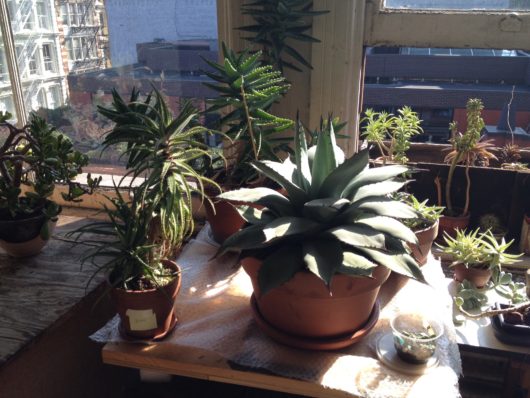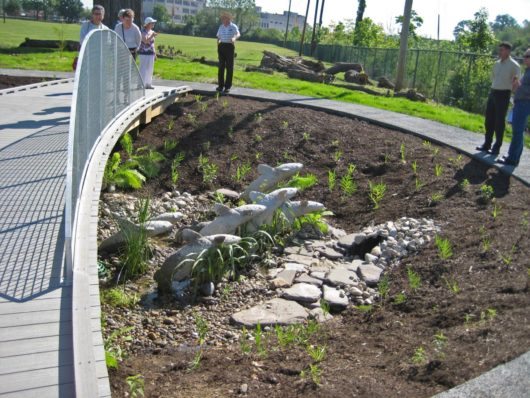
Jackie Brookner
Editors Introduction:
Ground breaking ecoartist Jackie Brookner died in May 2015, at age 69. On a creative roll, she only regretted leaving so many unrealized ideas. But she had already created so much to be proud of.
In 1967 she earned her BA from Wellesley College and went on to Harvard University, where she abandoned studies toward an art history PhD in1971 to move to NYC to become an artist. The New York Studio School co-dean in the 1970s, she taught at Parsons New School for Design from 1980 until her death.
In 1995, a successful exhibiting sculptor, she began incorporating bioremediation–nature to heal nature. Plants within her organic sculptures and landscape scale installations modeled how to clean degraded water. Inviting community collaboration, she worked nationally and globally. http://www.jackiebrookner.net/
I take great pleasure in introducing curator (ecoartspace) Amy Lipton’s personal essay on Jackie. Amy became Jackie’s friend as they worked together on several projects. Appropriately, last fall, in memoriam, she co-curated Jackie’s first retrospective at Glyndor Gallery, Wave Hill, Bronx, NY.
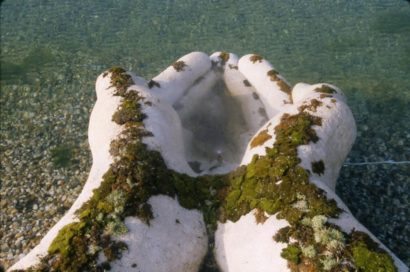
THE GIFT OF WATER, Grossenhain, Germany.
IT HAS BEEN ALMOST 20 years since I first met artist Jackie Brookner at a studio visit in her live/work plant-filled loft on Spring Street in Soho, where she had lived since 1977. Walking into Brookner’s studio I encountered the enormous presence of Prima Lingua (First Language/First Tongue) 1995, a large tongue form covered in ferns and mosses as circulating water trickled down over its rocky surface into a pool below. Brookner titled this and her subsequent ecological works as ‘biosculptures’. She described her interest in the tongue as being the physical embodiment of the mind and the body, a place where taste, sex and speech meet. Prima Lingua was my first encounter with a living breathing work of art.
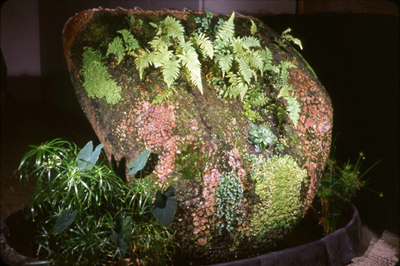
PRIMA LINGUA
Brookner had a profound influence on my career as a curator. She introduced me to an endless list of reading material and a group of ecological artists who had formed an online discussion group. One of the first books she loaned me, Thomas Berry’s ‘The Dream of the Earth’, was crucial to my own understanding of the relationship between art and the natural world.
Brookner was passionately dedicated to her art and not at all concerned with the ‘art world’. She was disciplined, fervent and committed to daily work in the studio. She also had a reverence for nature and life that spilled over into all aspects of her art making and into her relationships. Her deep, philosophical understanding of life’s processes went beyond the art studio, into the worlds of science, religion, culture, politics, activism and community both locally and globally. Hers was ultimately a spiritual art practice that she embraced as a holistic vision of interconnection. In her lectures and teachings she always emphasized the interdependence of all life.
Of particular interest to Brookner was the concept of porousness and eradicating boundaries – between each other and between all living things, including the planet. Raised Jewish but not traditionally religious, she introduced me to the writings of Rabbi Arthur Waskow, a leader in the Jewish Green Renewal movement. His concepts regarding the spiritual importance of the act of breathing itself had an important influence on Brookner’s work. A belief in the sacredness of life- rocks, plants, soil, water, and creatures large and small – underlies all of her later work, personal and public, in the studio and in the world.
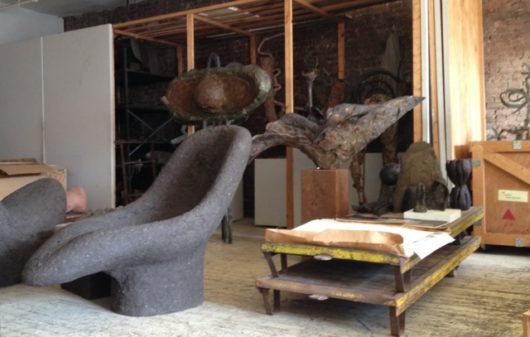
Brookner’s Studio with TONGUE LOUNGE
Working with Brookner I broadened my understanding of ecological principles and was introduced to scientific language and concepts. In her approach to this work however, she never left aesthetics behind. Her primary strength was an ability to bring social, environmental and scientific concepts into physical form while maintaining her strong training in formal sculptural principles. Prior to Prima Lingua, Brookner was using the form of the human tongue, she was interested in exploring the roots of language. Her Tongue Lounge (1993) chairs, were made of soil and functioned as seating. Brookner delighted in inviting studio guests to have a seat and experience the rocking motion of the tongues, where ‘earth can embrace the whole body.”

Brookner’s Studio drawings.
She also made many large formal drawings and sketches using the tongue form. Some are abstracted from natural patterns and some loosely depict human figures; hands, heads and feet. She would often use wet soil as a drawing medium, her painterly mud gestures left a cracking surface residue on the paper that remains. This exhibition title Of Nature stems from Brookner’s endless fascination with and use of soil in her later work.
I was thinking a lot about why we’re doing what we’re doing to the earth, besides the capitalism and the greed. What are some of the deep, psychological roots of our catastrophic destruction? This gradually became evident to me as I was working on the chairs.
I think it’s got a lot to do with control and death and that we associate death with the death of the body. We know the body dies and the matrix of the body for us, our material nature, is matter. For me, soil as a sculptural material is a kind of ground-level metaphor for matter.
I started thinking about why we call soil ‘dirt’ and what dirt means as a word. Dirt is associated with excrement, sex, dirty jokes. What are these connections? I think they meet ultimately in death and in our fear of our mortality. I propose that collectively, especially in patriarchal culture, we are furious that the earth does not give us immortality. Mater is the etymological root of the matter, material and mother. So in this control-hungry culture we’re furious at the mother, mater, matter. – Jackie Brookner, in dialogue with Maxine Levin, National Soil Survey Center, U.S. Department of Agriculture

Detail, I’M YOU, Ecoventions, Cincinnati Contemporary Art Center, 2002.
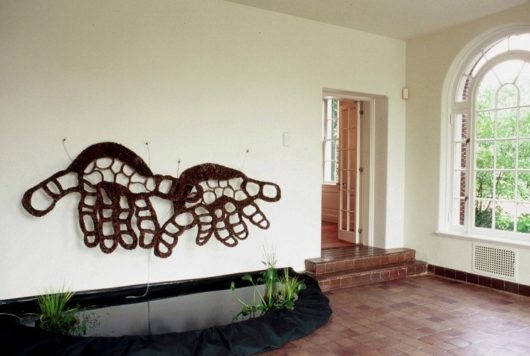
I’M YOU, Ecoventions, Cincinnati Contemporary Art Center, 2002.
Brookner expanded on her studio experiments with Prima Lingua and I’m You (2000) to activate these concepts on a larger scale in the public realm through participating in Ecovention: Current Art to Transform Ecologies an exhibition that I co-curated with Sue Spaid at the Cincinnati Museum of Contemporary Art in 2002.
Brookner was selected to create a project that resulted in Laughing Brook (2002-2009). Laughing Brook was a collaboration with Cincinnati Parks and Recreation, Mill Creek Restoration Project, landscape architects HumanNature Inc. and a group of local high school students who, working with Brookner got hands-on experience with creating and casting a series of 106 biosculptures. These plant based systems clean polluted water, integrating ecological revitalization with the conceptual, metaphoric and aesthetic capacities of sculpture. The wetland habitats of Laughing Brook, filter storm water runoff from adjacent parking lots, and 3 acres of ball fields before the water enters the severely endangered Mill Creek. The water first pours into biosculptures in the form of human hands and then as the stream moves toward the creek the hands transform into fish. Mosses cover the sculptural elements and as water flows over them the plants and associated bacteria transform toxins into food by using pollutants as resources for their own metabolism. Laughing Brook includes wetland and prairie landscapes, butterfly gardens, native plant nurseries, walkways, seating and river overlooks and is sustained and enjoyed by the public.

LAUGHING BROOK, Salway Park, Cincinnati OH.

LAUGHING BROOK, Salway Park, Cincinnati OH.
Ecological public art projects such as this one require the perseverance of an artist like Brookner who can sustain working with the complex processes of civic bureaucracy and remain in dialogue with stakeholders, while negotiating with them on every level.
They also require a high degree of collaboration which Brookner became interested in while working on her major project, Of Earth and Cotton (1994-1998).
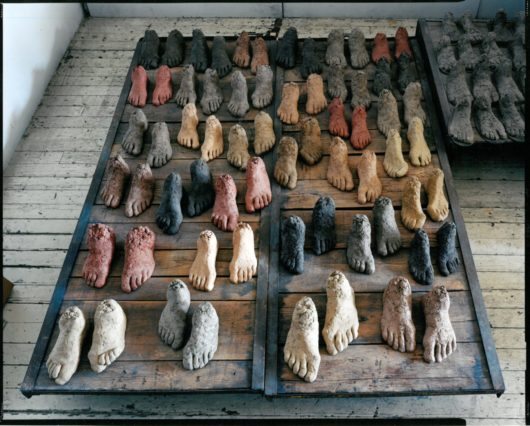
OF EARTH AND COTTON. Photo credit: Mitch Epstein.
This was a turning point in Brookner’s career when making studio art lost its significance and she became intent upon working in the social sphere with community upfront and foremost. Her work went beyond what we typically think of as public art into the realm of direct cultural engagement and ultimately towards functionality.
As seen in Prima Lingua and the transition from hands to fish in Laughing Brook, Brookner’s interest in sculptural forms frequently represent the human body, namely tongues, hands and feet. She used these truncated parts of our anatomy because we can intimately relate to them as embodied experience. Her desire was to critically confront unsustainable ways of envisioning ourselves and the world as discrete from ourselves.
Brookner joined artist Hana Iverson and engineer Pramod Abichandani in 2014 on their plans for a collaborative public work – The Breath Project. Their goal was a global vision for healing and peace focused on the act of breathing. The concept is to visualize the significance that everyone on this planet shares a life force by breathing in the oxygen that plants produce while taking in carbon dioxide in a continuous cycle of sharing. This public installation will be networked to gather data from the exchange of gases from human breath and plant respiration and will consist of a replicable interactive living landscape that connects to a water restoration project.
Though weakened from illness in 2015, The Breath Project inspired and gave Brookner the drive to continue working until the end of her life. The project held great fascination for her as it elucidated her long held interest in porousness and permeability and demonstrates interdependence and the ability of the shared action to have a remediating influence upon the environment.
I was very fortunate to work with Jackie Brookner on a variety of projects and programs. She inspired me with her passion, vision and generosity of spirit. I will be giving my curatorial support towards the fruition of The Breath Project as I know from my final conversations with her that she firmly envisioned its realization.
JACKIE BROOKNER QUOTES
“Amidst the epic scale of our self destructiveness and the acuteness with which we refine our deadly powers, is it trivial to point to the unintentional fallout of the daily round of our lives, of the extinction of fish and birds, plants and land animals, and the burdens of pollution we excrete into the world’s waters and air? I think not. It’s all part of the same scenario of self destruction, depending, of course, on what we mean by self. Reasonable beings, we use our reason as reason enough to separate ourselves from other animals. But the root of the word animal tells a different story. The Latin animus means soul, air and breath, life principle. Rather than separating us, it is about what connects us to the rest of breathing creatures and to air, life’s breath itself. How can we rediscover this sense of connectedness? Can we find our way out of our destructive and atavistic patterns to imagine a more accurate sense of ourselves, where we can recognize and even celebrate our necessary immersion in the rest of creation?” – Jackie Brookner
MORE INFO ABOUT JACKIE:

